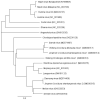Recently Emerged Novel Henipa-like Viruses: Shining a Spotlight on the Shrew
- PMID: 38140648
- PMCID: PMC10747904
- DOI: 10.3390/v15122407
Recently Emerged Novel Henipa-like Viruses: Shining a Spotlight on the Shrew
Abstract
Henipaviruses are zoonotic viruses, including some highly pathogenic and capable of serious disease and high fatality rates in both animals and humans. Hendra virus and Nipah virus are the most notable henipaviruses, resulting in significant outbreaks across South Asia, South-East Asia, and Australia. Pteropid fruit bats have been identified as key zoonotic reservoirs; however, the increased discovery of henipaviruses outside the geographic distribution of Pteropid fruit bats and the detection of novel henipa-like viruses in other species such as the shrew, rat, and opossum suggest that Pteropid bats are not the sole reservoir for henipaviruses. In this review, we provide an update on henipavirus spillover events and describe the recent detection of novel unclassified henipaviruses, with a strong focus on the shrew and its emerging role as a key host of henipaviruses.
Keywords: henipavirus; outbreak potential; paramyxovirus; pteropid bat; reservoir host; shrew; virus; zoonotic.
Conflict of interest statement
The authors declare no conflict of interest.
Figures


Similar articles
-
A Comparative Assessment of the Pathogenic Potential of Newly Discovered Henipaviruses.Pathogens. 2024 Jul 16;13(7):587. doi: 10.3390/pathogens13070587. Pathogens. 2024. PMID: 39057814 Free PMC article. Review.
-
Henipaviruses: an updated review focusing on the pteropid reservoir and features of transmission.Zoonoses Public Health. 2013 Feb;60(1):69-83. doi: 10.1111/j.1863-2378.2012.01501.x. Epub 2012 Jun 18. Zoonoses Public Health. 2013. PMID: 22709528 Review.
-
Discovery and Genomic Characterization of a Novel Henipavirus, Angavokely Virus, from Fruit Bats in Madagascar.J Virol. 2022 Sep 28;96(18):e0092122. doi: 10.1128/jvi.00921-22. Epub 2022 Aug 30. J Virol. 2022. PMID: 36040175 Free PMC article.
-
First Genomic Evidence of a Henipa-like Virus in Brazil.Viruses. 2022 Sep 30;14(10):2167. doi: 10.3390/v14102167. Viruses. 2022. PMID: 36298723 Free PMC article.
-
The distribution of henipaviruses in Southeast Asia and Australasia: is Wallace's line a barrier to Nipah virus?PLoS One. 2013 Apr 24;8(4):e61316. doi: 10.1371/journal.pone.0061316. Print 2013. PLoS One. 2013. PMID: 23637812 Free PMC article.
Cited by
-
Indiscriminate activities of different henipavirus polymerase complex proteins allow for efficient minigenome replication in hybrid systems.J Virol. 2024 Jun 13;98(6):e0050324. doi: 10.1128/jvi.00503-24. Epub 2024 May 23. J Virol. 2024. PMID: 38780245 Free PMC article.
-
A Comparative Assessment of the Pathogenic Potential of Newly Discovered Henipaviruses.Pathogens. 2024 Jul 16;13(7):587. doi: 10.3390/pathogens13070587. Pathogens. 2024. PMID: 39057814 Free PMC article. Review.
-
Pathology and host-pathogen interactions in a golden Syrian hamster model of Nipah virus infection.Front Vet Sci. 2025 Mar 7;12:1518358. doi: 10.3389/fvets.2025.1518358. eCollection 2025. Front Vet Sci. 2025. PMID: 40125323 Free PMC article.
-
Henipaviruses: epidemiology, ecology, disease, and the development of vaccines and therapeutics.Clin Microbiol Rev. 2025 Mar 13;38(1):e0012823. doi: 10.1128/cmr.00128-23. Epub 2024 Dec 23. Clin Microbiol Rev. 2025. PMID: 39714175 Free PMC article. Review.
-
Paramyxo- and coronavirus diversity and host associations in non-volant small mammals: evidence of viral sharing.Virus Evol. 2025 May 22;11(1):veaf041. doi: 10.1093/ve/veaf041. eCollection 2025. Virus Evol. 2025. PMID: 40584258 Free PMC article.
References
-
- ICTV Genus: Henipavirus. [(accessed on 18 August 2023)]. Available online: https://ictv.global/report/chapter/paramyxoviridae/paramyxoviridae/henip....
-
- Centers for Disease Control and Prevention Outbreak of Hendra-Like Virus—Malaysia and Singapore, 1998–1999. [(accessed on 24 April 2023)]; Available online: https://www.cdc.gov/mmwr/preview/mmwrhtml/00056866.htm.
Publication types
MeSH terms
LinkOut - more resources
Full Text Sources

